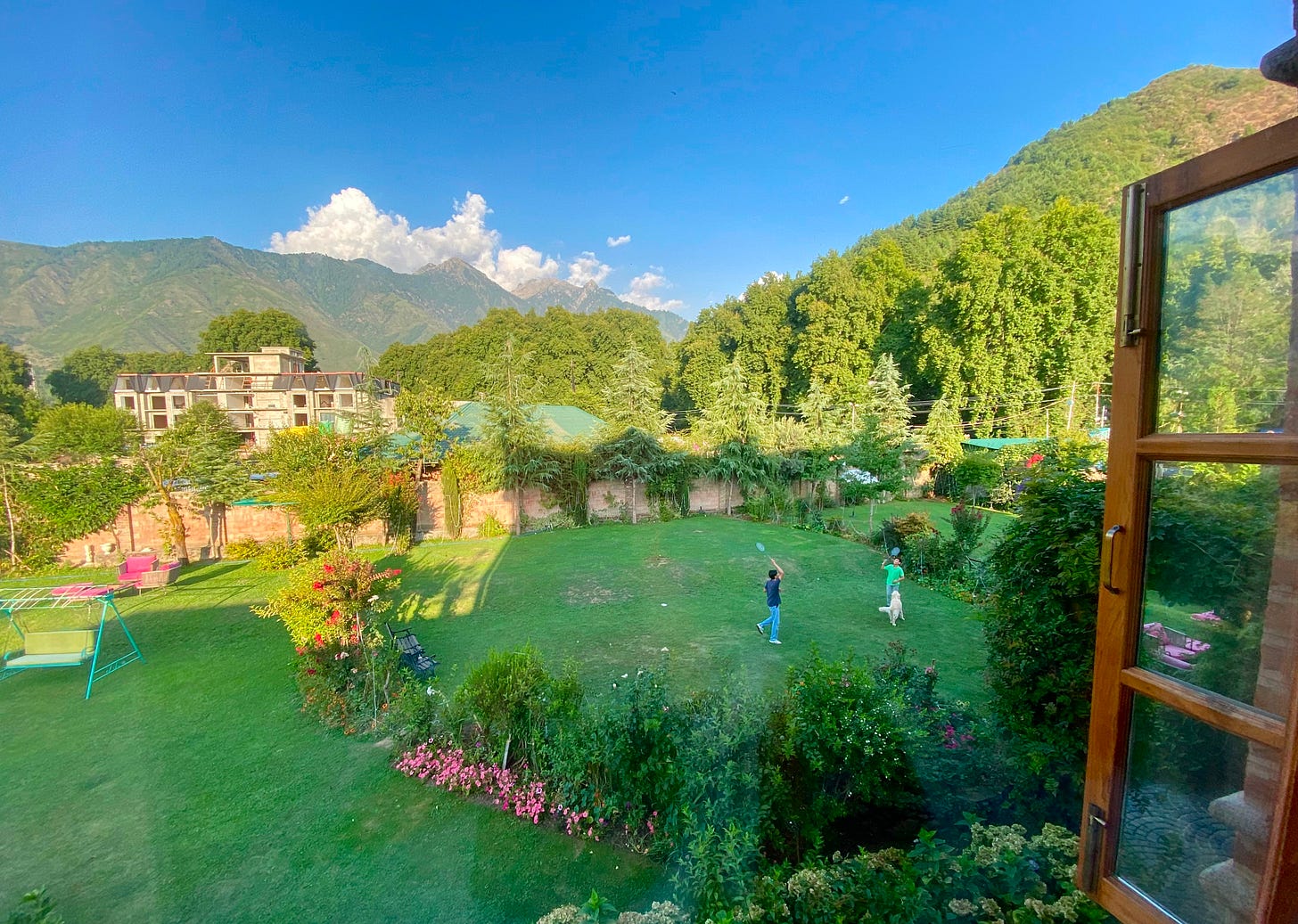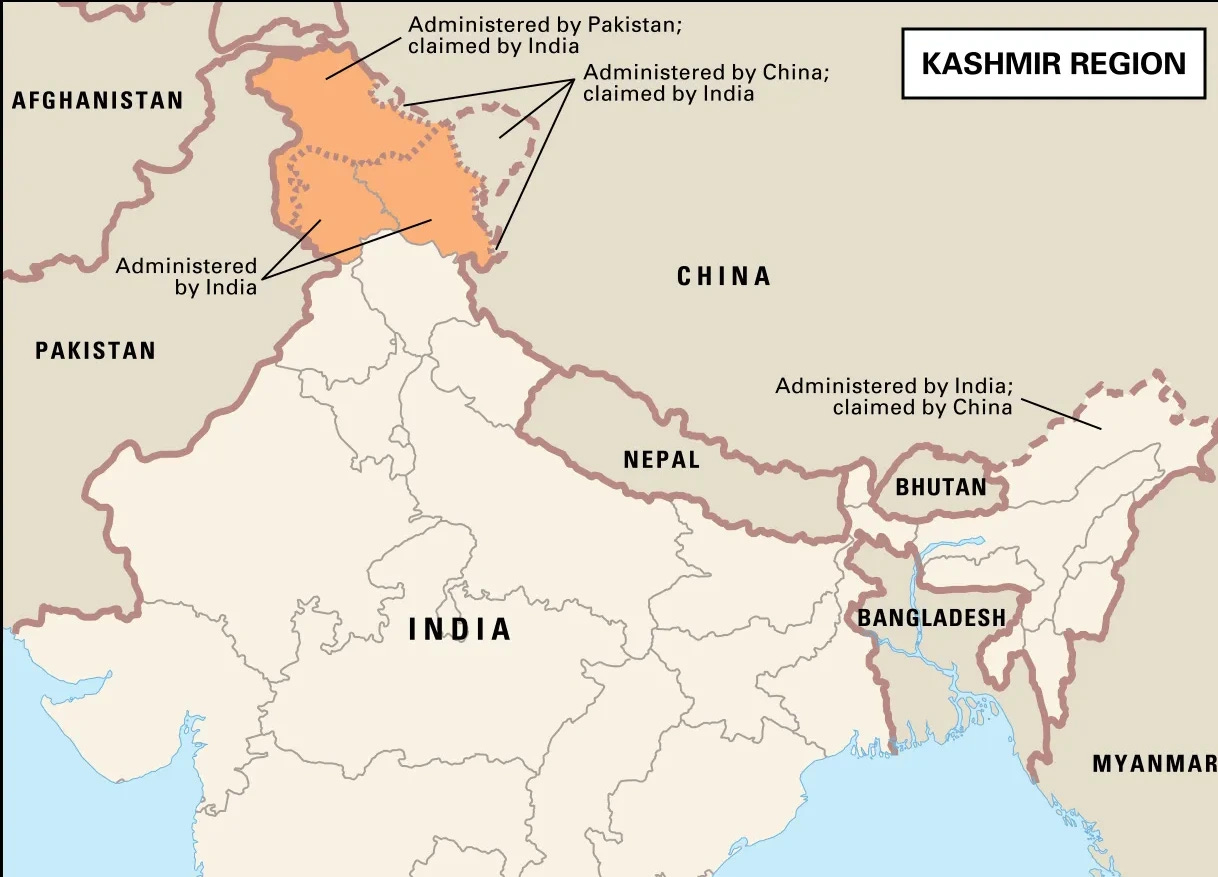Hola Global Jigsaw,
After an August of traveling in India, we are back. Today’s post is the first of a three-part series on Kashmir and Ladakh. Please do consider upgrading to paid subscriber, so that I can try and recoup some of the expenses this travel entailed! Why did I become a writer instead of an investment banker?!
xxx
“Anyone want a chicken salami sandwich?” called out a middle-aged man dressed in a flowery shirt that looked determined to party as it stretched across his undulating midriff. “Me!” my older son, Ishaan, began to answer, his hand shooting up in enthusiastic acquiescence. I pulled his arm down and sharply whispered that the question wasn’t meant for us, but for the large group of friends that the bearer of chicken salami was traveling with. “Oh, he’s not the steward?” asked Ishaan, confused.
We were aboard a plane from New Delhi to Srinagar, the fabled capital city of Kashmir in the high north of India. A place of lush green valleys, fringed with snow topped mountains; of apple orchards and singing rivers. A place both exotic to mainland India, and yet very much part of its core fantasies – nationalist and romantic.
It is where the song and dance interludes of Bollywood movies of a certain vintage unfolded with much running around the trees of the city’s famous Mughal gardens, in a demonstration of pre-coital exuberance by the hero and heroine. In the first few decades of independent India there were no words more romantic than a young man whispering into his shy lover’s ear, “Kashmir chale?” Shall we go to Kashmir? A phrase drowning in a honeymoon syrup, with amorous freedom as the top note.
View from our hotel window in Srinagar. My boys (and a dog) playing badminton. Pic: Pallavi Aiyar
But by the 1980s, Kashmir had become more redolent with blood and bombs than Bollywood, as it emerged as the site of a brutal tango between radical Islamic militants and trigger-happy Indian army counterinsurgents. Gardens and pashmina shawls gave way to the bullet-ridden bodies of young men and the tear-ravined cheeks of their mothers, as the region’s dreamlike landscape morphed into a living nightmare. Bollywood dream sequences moved on to Switzerland.
xxxx
Kashmir’s curse is its antique DNA as a crossroads, unconstrained by the usual determinants of geography and nationality. A place of mélange rather than purity, of cultural fluidity and caravan sarais. A place through which traders, pilgrims and conquerors passed and stayed. Crossroads do not sit comfortably within national boundaries. The difficulty in claiming them as this or that, rips their existential fabric into bloodied pieces to be fought for, like dogs teasing at a bone.
The region borders Xinjiang to the northeast and Tibet to the east, both “part” of China and equally resistant to being cinched into national corsets. To its west lie Pakistan and Afghanistan.
This cauliflower shaped head of India, has been a palimpsest of religions. Buddhism was introduced by the Mauryan emperor Ashoka in the 3rd century BCE. Later, from the 9th to the 12th century CE Hinduism gained ascendancy. By the 14th century, a majority of Kashmiris had converted to Islam, largely under the influence of mystical Sufi preachers from Central Asia and Persia. In 1586, the kingdom was annexed by the Islamic Mughal Empire that ruled over much of northern India. This rule ended when it was taken over by the Sikh kingdom of the Punjab in 1819, and then by the multi-religious Dogra kingdom of Jammu, in 1846. But despite the revolving door of rulers at the top, the majority of the people in the Kashmir valley remained Muslim.
In 1947, when India gained her independence from British rule, Kashmir, like other princely states that were not formally part of the Raj, was given the choice to accede to either India, or the newly formed Muslim nation of Pakistan. Kashmir’s ruler, Hari Singh, was a Hindu, who had fantasies of remaining independent. But by October 1947, facing an invasion of tribesmen from Pakistan, he “gave” Kashmir to India, even though the majority of his kingdom’s population were Muslim and hadn’t been given any choice in the matter.
A war erupted. India approached the United Nations asking it to intervene. The UN recommended holding a plebiscite to settle the question of whether the state would join India or Pakistan. However, India and Pakistan could not agree to a deal to demilitarize the region, a precondition for the referendum. More than 70 years later, it has still not been held.
The result is that while both countries claim the region in its entirety, in practice they control it in part, areas that are internationally recognized as "Indian-administered Kashmir" and "Pakistan-administered Kashmir."
But it was in the 1980s that matters began took an intractably violent turn when against a backdrop of disillusionment with lack of progress through the democratic process, militant organizations in the Kashmir valley began to proliferate. The long years that followed had young men, often teenagers, trained in terrorist camps in Pakistan, or in Taliban controlled Afghanistan, face off against an Indian army with orders to eradicate them. Death stalked the mountains. Tourism to the region stopped.
Things gradually began to improve in the beginning of the new millennium, but Kashmir’s has continued to be a story of geopolitical football. In 2019, the Indian government revoked the area’s “special status” that had given it considerable autonomy on most legislative matters. To control the inevitable unrest that followed, telephone networks and the internet were cut off in the region. Public gatherings were banned, and tens of thousands of army troops were sent in. Tourists were told to leave Kashmir under warnings of a terror threat. (I wrote a piece comparing India’s actions in Kashmir to China’s in its peripheral areas, here).
xxx
When I first began to plan this year’s summer holiday, I had in mind to travel to Ladakh, the Buddhist area that abuts the Kashmir valley. This is somewhere you can imagine Richard Gere sipping butter tea and smiling beatifically under a string of colorful prayer flags, a yak or two grazing in the distance. But after speaking with people in the know, I was advised to first fly into Srinagar and after a few days drive up to Ladakh, in order to avoid altitude sickness. Leh, Ladakh’s capital, is at an elevation of 3,500 meters.
I was apprehensive. Not because of the possibility of getting caught in some kind of crossfire, but because I did not like the idea of partaking in misery porn. Srinagar, I imagined, would be a city manifestly held together by army tanks. A surly populace being forced to perform hospitality for visitors. My travel agent interlocutor was dismissive. “After 2019, everything is good. You will be surprised,” he said.
Kashmir exerts an elemental pull for any Indian. The last time I was there was in the early 80s, as a primary schooler. I was curious. I wanted my children to understand something of their complicated motherland.
It was short flight from Delhi and the hotel we had booked, Nadis, was almost as long a drive from the airport. But it turned out to be worth it. The property’s lawns were so green they took a harp to the heart. As we began the check in procedures, a familiar sight greeted us. It was Mr. Chicken Salami and his party shirt, along with what looked like all the rest of the passengers from our plane that morning.
At reception we were informed that the hotel had been booked for three nights (exactly our length of stay) by a group from Delhi for a 50th birthday party. We were the only non-birthday guests in the hotel.
xxx
Next week, more on our adventures in Kashmir and beyond. Hope its been a good August for you, dear reader. Please write in with comments, queries, suggestions or good wishes. I love hearing from you.
Hasta pronto,
Pallavi






Hi there Pallavi, this is an interesting article . I visited Srinagar with friends at the end of our House officer posts, in 1975. One of our classmates served as a military doctor there during Kargil war . I would like revisit the place now !
Looking forward to the next article. I love the way you observe and interpret.